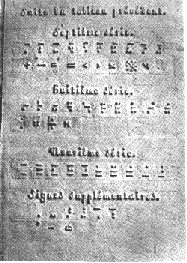|
National Literary Braille Competency Test
Part One: Writing Skills
There are two sections to this part of the test. In Section A you are asked to transcribe accurately one medium-length print paragraph. In Section B you are asked to transcribe accurately one full print page. While the National exam asks you to do Section A with a slate and stylus, and Section B with a Perkins, we are asking that both sections be done using whatever tool you have used to submit earlier work (with a preference on electronic braille software).
(Both selections are taken from published materials).
You may refer to a dictionary for word divisions, but you may not use other reference materials. Because the literary code does not specify formatting for this type of material, formatting information is included in the instructions.
Scoring: You will start with a score of 100 (50 per section). Points will be deducted for errors. If the same error in the use or omission of contractions occurs consistently in the same word, it will be counted only once. Consistent format errors will be counted together as a single error.
Section A and Section B will be scored separately. A minimum score of 41 points out of 50 in each section will be required to pass the section. A minimum combined score of 85 will be neccessary to pass Part One.
The following are considered to be errors. Three (3) points will be deducted for each occurrence.
- Contractions omitted or misused
- Characters misformed (including added or omitted dots)
- Incorrect division of words
- Letters inserted or omitted
- Text inserted, omitted, or repeated
- Spacing errors
- Format irregularities
- Omitted or inserted punctuation or composition signs
- Erasures detectable by touch
Part One, Section A
Transcribe the following passage .
More than thirty thousand species of fish inhabit fresh and saltwater areas on our globe. It is estimated that each year nearly one hundred and fifty million residents of the United States fish as a recreational activity; many hundreds fish as an occupation; and hundreds of thousands do not actively angle but enjoy reading about the sport. Fish may be caught by trolling, casting, and still fishing. Even more may be held in the mind through reading. Successful anglers should know where the fish are at any given time and season, how to hook them, and, most important, how to describe the actual landing of the catch. Books can introduce you to the experience of a blind fisherman and explain how a licensed guide assists young blind people in learning the techniques of fishing. Blind and physically handicapped anglers can share these experiences and, indeed, many do. So, go forth and fish.
End of Secion A
Part One, Section B
Transcribe the following material.
Format: Use the maximum space possible on each braille line. Hyphenate where necessary.
For the following material, center the exercise heading as shown below. Skip one line between the exercise heading and the following paragraph. Also, skip one line between the paragraph and the first numbered item and one line between the last numbered item and the following paragraph. Transcribe the numbers at the left margin. If more than one braille line is required to complete the information under a particular number, begin the additional line(s) in cell 3. It is not necessary to braille the words "End of Part One" at the end of Section B.
Doctoral Research
The final dissertation reported was Kenneth Leon Ferstl's "Public Librarians and Service to the Aging: A Study of Attitudes" prepared in 1977 for Indiana University. The purpose of Ferstl's study was threefold:
(1) to ascertain the extent to which attitudes held by public librarians were in accord with the principles stated in "The Library's Responsibility to the Aging";
(2) to ascertain the extent to which attitudes of public librarians were in accord with the principles and standards pertinent to library services to the aging;
(3) to determine the attitudes of public librarians toward commonly accepted misconceptions and stereotypes held about the aged and to what extent the attitudes held differ.
Data were gathered using a questionnaire completed by 229 public service librarians. Of the stereotypes and misconceptions related to the physical characteristics of older adults, the respondents tended to agree that older adults walk slowly and need glasses to read. However, they strongly refuted the concepts that: (a) older people have poor coordination, (b) are hard of hearing, (c) feel tired most of the time, (d) have to go to bed early, and (e) are confined to bed a great deal because of illness. All of the stereotypes related to the mental deterioration of older people were rejected by the respondents.
End of Section B
| 
